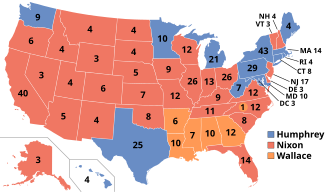
Back Трэція партыі (ЗША) Byelorussian پارتی سێیەم (سیاسەتی ئەمریکا) CKB حزب سوم (ایالات متحده آمریکا) Persian מפלגה שלישית (ארצות הברית) HE Þriðju flokkar í Bandaríkjunum Icelandic Terzo partito (Stati Uniti d'America) Italian Terceiro partido (Estados Unidos) Portuguese Третьи партии Russian 第三党 (美国) Chinese
Third party, or minor party, is a term used in the United States' two-party system for political parties other than the Republican and Democratic parties. The plurality voting system for presidential and Congressional elections have over time helped establish a two-party system in American politics. Third parties are most often encountered in presidential nominations and while third-party candidates rarely win elections, they can have an effect on them through vote splitting and other impacts.
With few exceptions,[1] the U.S. system has two major parties which have won, on average, 98% of all state and federal seats.[2] According to Duverger's law two main political parties emerge in political systems with plurality voting in single-member districts. In this case, votes for minor parties can potentially be regarded splitting votes away from the most similar major party.[2][3] Third party vote splitting exceeded a president's margin of victory in three elections: 1844, 2000, and 2016.
There have only been a few rare elections where a minor party was competitive with the major parties, occasionally replacing one of the major parties in the 19th century.[3][4] No third-party candidate has won the presidency since the Republican Party became the second major party in 1856. Since then a third-party candidate won states in five elections: 1892, 1912, 1924, 1948, and 1968. 1992 was the last time a third-party candidate won over 5% of the vote and placed second in any state.[5]
- ^ Arthur Meier Schlesinger, ed. History of US political parties (5 vol. Chelsea House Pub, 2002).
- ^ a b Masket, Seth (Fall 2023). "Giving Minor Parties a Chance". Democracy. 70.
- ^ a b Blake, Aaron (November 25, 2021). "Why are there only two parties in American politics?". Washington Post. ISSN 0190-8286. Retrieved September 25, 2023.
- ^ Riker, William H. (December 1982). "The Two-party System and Duverger's Law: An Essay on the History of Political Science". American Political Science Review. 76 (4): 753–766. doi:10.1017/s0003055400189580. JSTOR 1962968. Retrieved April 12, 2020.
- ^ O'Neill, Aaron (June 21, 2022). "U.S. presidential elections: third-party performance 1892-2020". Statista. Retrieved May 25, 2023.




